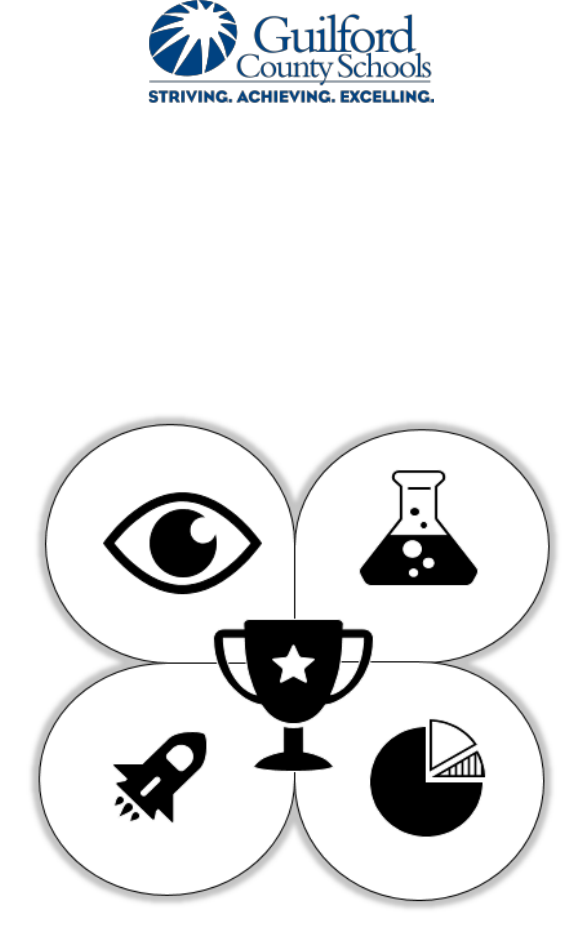2
Table of Contents
Getting Started ………………….……………………………………………………... 3
Risks and Safety Forms………………………………………………………………… 3-5
Scientific Process……………………………………………………………………….. 6
Research Plan…………………………………………………………………………… 6
Steps of the Scientific Method………………………………………………………… 6-9
Putting It All Together………………………………………………………………… 10
Example of a Science Fair Project…………………………………………………….. 11-12
Bibliography Guide…………………………………………………………………….. 13
GCS Science Project and Research Plan Approval Form …………………………..… 14
Project Template Guide………………………………………………………………... 15
Experiment Research Plan………………………………………………………………... 16-18
Science Project Checklist.…………………………………………………………………………19

3
Important things to know before getting started:
Participation in the Guilford County Schools Science Fair is open to all students (K-12).
Students may work individually or in groups of two-three to conduct their experiments
using the steps of the Scientific Method.
Your child’s teacher will provide a science fair project schedule for all the key due dates.
Help your child meet these dates by getting out your family calendar and marking the due
dates. Block out times for trips to the library, afterschool visits with teachers, and/or other
work time. If there are any scheduling conflicts, please discuss with the teacher.
Getting Started
To get started, get familiar with some of the basics. There are different types of science projects.
Experiments are fun, interesting, and they take you through the scientific method.
Experimentation includes asking questions, making observations, gathering and organizing data,
and drawing conclusions. For example, experimental questions like “What Type of Shoes Are
Best for Playing Volleyball?” and “The Effect of Bleach on Plant Growth” lead to
experimentation.
Models (or displays) show how something works but do not test anything or provide new
information. Examples of models/displays include “Types of Dinosaurs” and “Creating a
Volcano Using Baking Soda and Vinegar.”
Risks and Safety
Projects involving human subjects or surveys will require a school-based Institutional Review
Board (IRB) committee to review and sign off on projects before experimentation begins. This
committee (science educator, school administrator, and an individual knowledgeable in
evaluating the physical or psychological risk) determines the risk of these projects. Please refer
to Form 4 (Appendix A) included in this packet.
High risk projects require extra forms that must be completed before experiments begin. High
risk projects involve: vertebrate animals, hazardous biological agents or hazardous chemicals,
and devices. These types of projects require a school level Scientific Review Committee (SRC).
Please refer to the ISEF (International Science and Engineering Fair) rules
(https://student.societyforscience.org/intel-isef) for detailed information or contact your student’s
teacher.

4
Elementary
Microorganisms - Due to the risks and safety rules associated with culturing microorganisms,
elementary projects involving the culturing of microorganisms are NOT ALLOWED, with the
exception of the following:
Experiments using Baker's/Brewer's yeast, for example: bread yeast
Experiments using lactobacillus or probiotic cultures (for example: yogurt, buttermilk, or
commercially available probiotic supplements)
Microorganisms include, but are not limited to: bacteria, fungi (including molds), yeasts, viruses,
viroids, prions, rickettsia, and parasites. Elementary projects cannot grow any bacteria or mold,
including bread mold.
These rules do not apply to projects involving composting or decomposition of foods as long as
no samples are cultured/grown and as long as all projects in these categories are
terminated/ended at the first visible signs of microbial growth (for example: when a mold or
fungus is visible).
Secondary (Middle and High)
Bacteria and fungi are considered high risk projects for secondary (middle and high school)
projects. Students cannot grow any bacteria or mold at home, including bread mold. Mold
must be grown in a lab under the supervision of a qualified scientist. Exceptions include using
Baker’s/Brewer’s yeast (bread yeast), lactobacillus or probiotic cultures (yogurt, buttermilk).
These rules do not apply to projects involving composting or decomposition of foods as long as
no samples are cultured/grown and as long as all projects in these categories are
terminated/ended at the first visible signs of microbial growth.
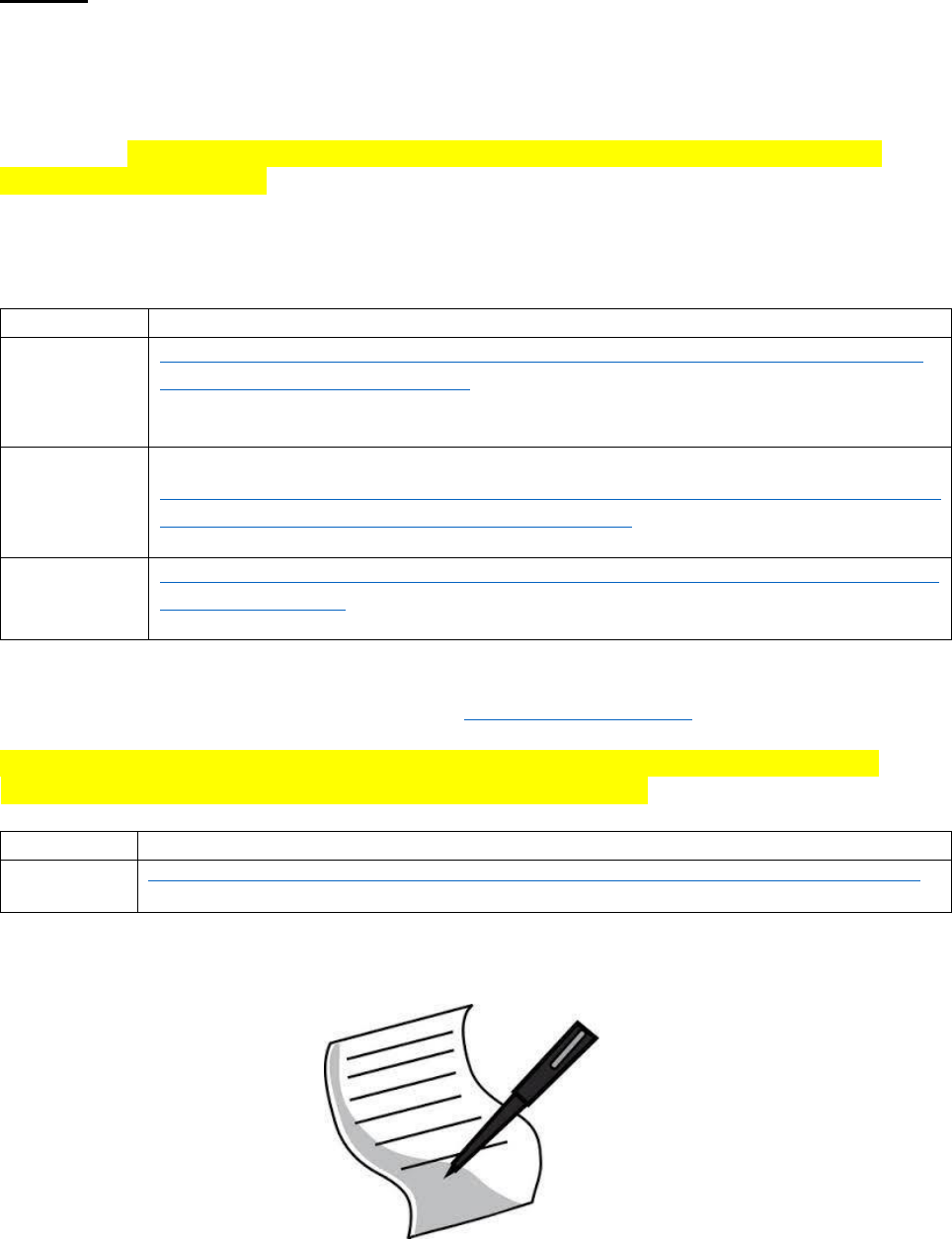
5
Forms
Forms must be completed and signed prior to experimentation.
GCS Science Project and Research Plan Approval Form is required for all grades and is included
in this packet on page 14.
High School students must complete Forms 1, 1A, and 1B. Grades K-8 do not need to complete
these forms. These forms are included in this packet in Appendices B, C, and D and they are
available in the links below.
Please see your teacher for additional copies of the required forms.
9-12 Science Project and Research Plan Approval Forms
FORM
LINK
Form 1-
Checklist for
Adult
Sponsor
https://sspcdn.blob.core.windows.net/files/Documents/SEP/ISEF/2018/Forms/1-
Checklist-for-Adult-Sponsor.pdf
Form 1A-
Student
Checklist
https://sspcdn.blob.core.windows.net/files/Documents/SEP/ISEF/2018/Forms/1A-
Student-Checklist-Research-Plan-Instructions.pdf
Form 1B-
Approval
Form
https://sspcdn.blob.core.windows.net/files/Documents/SEP/ISEF/2018/Forms/1B-
Approval-Form.pdf
Higher risk (includes animals and humans) projects will require additional forms. To obtain
forms, speak with your student’s teacher or visit www.nscsciencefair.org.
All students should complete the abstract once all experimentation is complete. The abstract
template is included in this packet and is available at the link below.
FORM
LINK
Abstract
http://www.ncsciencefair.org/images/forms/NORTH_CAROLINA_OFFICIAL_ABSTRACT.pdf

6
The Scientific Process
Research Plan
A research plan is a detailed summary of the project. It reflects what was actually done and
should match what is written in the abstract. The research plan is used for the Scientific Review
Committee (SRC) to assess if all International Science and Engineering Fair (ISEF) rules and
regulations were followed; therefore, it must be included with all paperwork. See pages 16-18 for
a research plan template. The research plan should include the following:
A. Problem/Rationale: Include a brief summary of the background information that
supports your research problem. Explain why this research is important and, if
applicable, explain how your research is relevant to society.
B. Research Question, Hypothesis, Engineering Goal, and Expected Outcome: Describe
the following in detail:
• Procedures: Detail all procedures and experimental design including methods
for data collection. Describe only your project. Do not include work done by a
mentor or other people.
• Risk and Safety: Identify any potential risks and safety precautions needed.
• Data Analysis: Describe the procedures you will use to analyze the data/results.
C. Bibliography: List major references (for example: science journal articles, books,
internet sites) from your literature review. If you plan to use vertebrate animals, one of
these references must be an animal care reference.
Steps of the Scientific Method
Step 1. Ask a Question
What interests you? What can you test? The question can be a simple one such as, “What kind of
paper makes the best paper airplane?”
The “Effect” Question:
What is the effect of _______________ on____________________?
sunlight the growth of plants
air temperature the size of a balloon
The “How Does” Question:
How does the ___________________ affect ___________________?
color of light the growth of plants
humidity the growth of fungi
color of a material its absorption of heat

7
The “Which/What” Question
Which/What _____________________ (verb) ______________________?
foods (do) meal worms prefer
type of soil (holds) the most water
Step 2. Develop Your Hypothesis
Can you PREDICT what you think will happen if you test your problem? This “smart guess” is
what scientists call a hypothesis. A hypothesis is a statement, not a question. The hypothesis is
an educated, testable prediction about what will happen.
Read about and discuss your topic. Be careful with websites; some are not considered
credible. Keep track of all the books, articles, and websites you read. You will need this
list for later. Talk with your teachers and professionals who study the topic.
Make it clear. A good hypothesis is written in clear and simple language. Reading your
hypothesis should tell a teacher or judge exactly what you thought was going to happen
when you started your project.
Keep the variables in mind. A good hypothesis defines the variables in easy-to-measure
terms, like who the participants are, what changes during the testing, and what the effect
of the changes will be.
Make sure your hypothesis is "testable." To prove or disprove your hypothesis, you need
to be able to do an experiment and take measurements or make observations to see how
two things (your variables) are related. You should also be able to repeat your experiment
over and over again, if necessary.
To create a "testable" hypothesis, make sure you have done all of these things:
Thought about what experiments you will need to carry out the test.
Identified the variables in the project.
Included the independent and dependent variables in the hypothesis statement. (This
helps ensure that your statement is specific enough.)
Sample Problem: How much water should I use when I water my plants?
Sample Hypothesis: If 50 mL of water are added to my plants each day and the plants grow, then
adding 100 mL of water each day would make them grow twice as much.
The sample hypothesis not only predicts what will happen in the experiment, but it also shows
that the “scientist” used research to back up his/her idea about what would happen.
When you write your hypothesis, it should be based on your "educated guess," not on known
data. Similarly, the hypothesis should be written before you begin your experimental
procedures—not after the fact.
"If _____ [I do this] _____, then _____[this]_____ will happen."

8
Step 3. Designing Your Experiment
First, determine what steps you will take and what variables you will change. The variables are
any factors that can change in an experiment. When you are testing, you should only change one
variable at a time in order to get accurate results.
Example:
You are testing the effect of water on plant growth. The only variable you would change from
plant to plant would be the amount of water it receives. The amount of water you give each plant
will be the Independent Variable. The Dependent Variable is the amount of growth for each
plant because the growth depends on the amount of water the plant receives. The Controlled
Variables stay the same and include the amount of sunlight, the type of plant, and the type of
soil.
If you are not able to distinguish your variables, then you will not be able to collect your data or
interpret your results.
Determine and gather the materials needed to carry out the investigation.
Step 4. Collect and Organize Your Data
Gather your materials and conduct your experiment.
Things to keep in mind:
Safety first! An adult must be present during every step of the experiment. Keep your
work area dry and clean; wear protective goggles if doing an experiment that could lead
to an eye injury. Always wash your hands after handling materials.
If possible, repeat the experiment at least three times to make sure the results are
consistent and reliable. These are referred to as trials.
Write down or record all of the results of the experiment every time you test it. All data
can help tell a story. Data that does not support your hypothesis are just as important as
data that do support your hypothesis.
Consider presenting your data not only with photographs and written summaries, but also
with tables and graphs. Please note that photographs of students are highly discouraged.
Step 5. Data Analysis
Now that you have conducted the experiment, take a closer look at the results. It is important to
construct an explanation and interpret the data.
Carefully review your data.
Calculate an average for the different trials of your experiment, if appropriate.
Clearly label all tables and graphs. Include the units of measurement (volts, inches,
grams, etc.).
Place your independent variable on the x-axis (horizontal) of your graph and the
dependent variable on the y-axis (vertical).
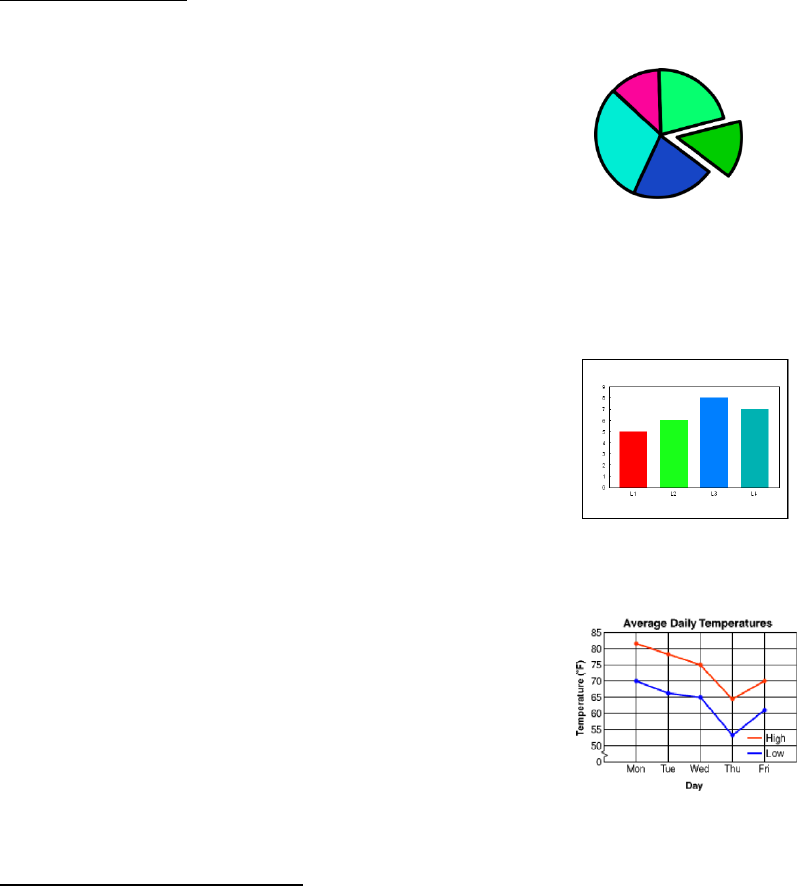
9
Types of Graphs
Pie charts are good to utilize if you are displaying data in percentages of groups. Remember that
all pieces need to add up to 100%.
Bar graphs are good to utilize for comparing amounts of things. Bar graphs allow you to see
your results at a glance. The x-axis (horizontal axis) is where you label what is being measured
(example: plant A, B, and C). The y-axis (vertical axis) is labeled to show the unit being
measured (example: centimeters that the plant grew).
Line graphs are good to utilize if you are showing how changes occur over time in your
experiment.
Step 6. Make a Conclusion
Your conclusion summarizes how your results support or contradict your hypothesis:
Was your hypothesis correct? State whether your results support or contradict your
hypothesis.
What did the data tell you? Summarize your science fair project results in a few
sentences and use this summary to support your conclusion. Include key facts from
your background research to help explain your results as needed.
How well did your experiment evaluate the question? Summarize and evaluate your
experimental procedure, making comments about its success and effectiveness.
What other questions did your observations raise? Suggest changes in the
experimental procedure (or design) and/or possible questions for further study.
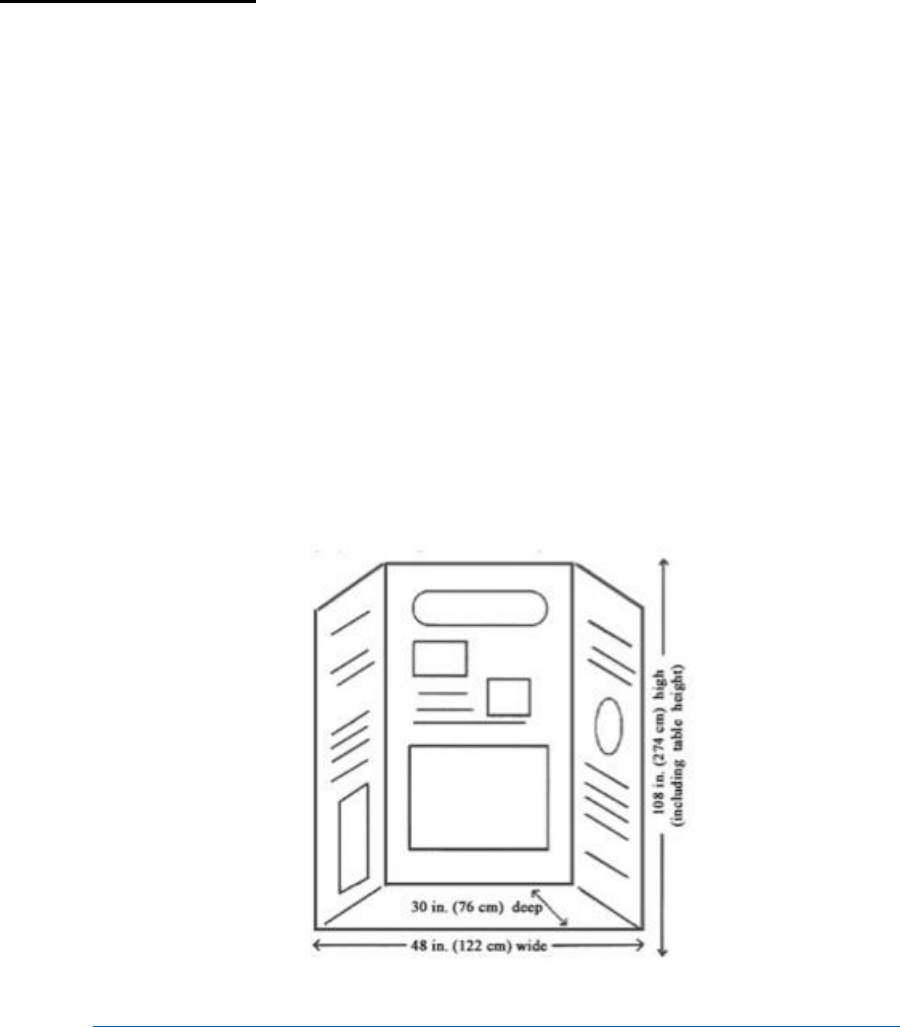
10
Putting it all together
Displays are restricted to a space of 122 cm / 48 in wide (side to side), 76 cm/ 30 in deep (front
to back), and 198 cm/ 78 in height (from tabletop), or 274 cm/ 108 in height (floor to top).
The illustration below is a display guide. Remember to place the information from left to right in
the general order that you performed each item. Include the following sections/information:
Project Title
Question/Problem/Purpose
Hypothesis
Materials
Step-by-Step Method/Procedure
Data Collection (displayed in a table or graph)
Variables (independent, dependent, and control variables)
Data Analysis (written in complete sentences)
Results/Conclusion (written in complete sentences and indicates if you proved or
disproved your hypothesis)
Adapted from
http://www.ncsciencefair.org/index.php/students-a-parents/rules/display-regulations
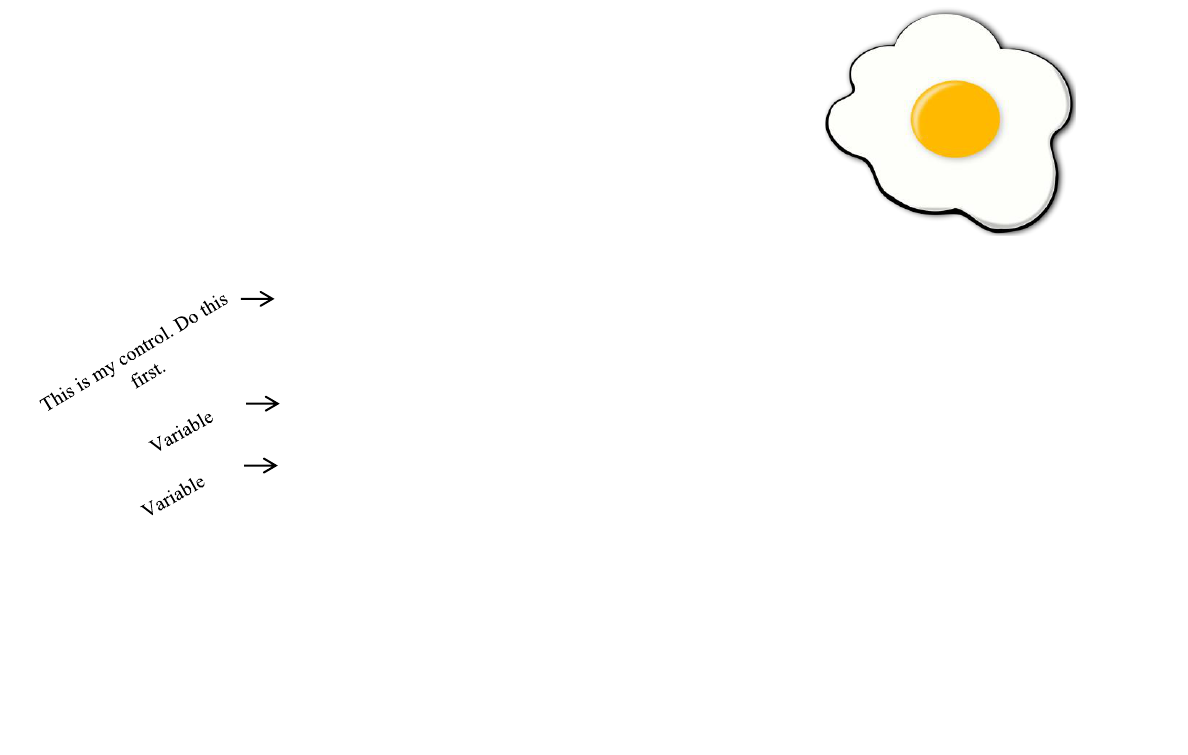
11
The following is an example of the results of a science fair project. It will help you
understand an experiment from beginning to end.
“You Gotta be Yoking!”
-project courtesy of GCS Elementary Student
1. Purpose/Problem (what you want to find out)
“I want to know if the number of eggs used in a brownie recipe changes the height
of the brownie once baked.”
2. Hypothesis (what you think will happen and why based on your previous
research)
“I think using one egg will make brownies shorter than my control because the
brownies will have less liquid.”
3. Materials (bulleted list of all items used to complete experiment)
9 boxes of brownie mix
18 eggs
Oven
Water
Pan, 9”x13”
Timer
Toothpicks
Ruler
4. Procedure (numbered list of all steps used to complete experiment)
1. Mix brownies following package directions, using 2 eggs. Complete 2 more
times.
2. Measure the height of all three control batches by using a toothpick inserted
into center. Compare against ruler.
3. Mix brownies following package directions, using 1 egg (3 times).
4. Measure each with a toothpick; compare against ruler.
5. Mix brownies following package directions, using 3 eggs (3 times).
6. Measure each with a toothpick; compare against ruler.
5. Constants (factors that do not change throughout trials)
“The brownie mix, oven temperature and bake time stay the same throughout my
experiment.”
6. Control (a trial that provides a baseline; used to compare other trial results)
“I baked my brownies according to the package directions, using 2 eggs.”
7. Variable(s) (one or more factors that change throughout trials)
“I had two variables. The first variable was using 1egg for 3 trials. The second
variable was using 3 eggs for 3 trials.”
1
0
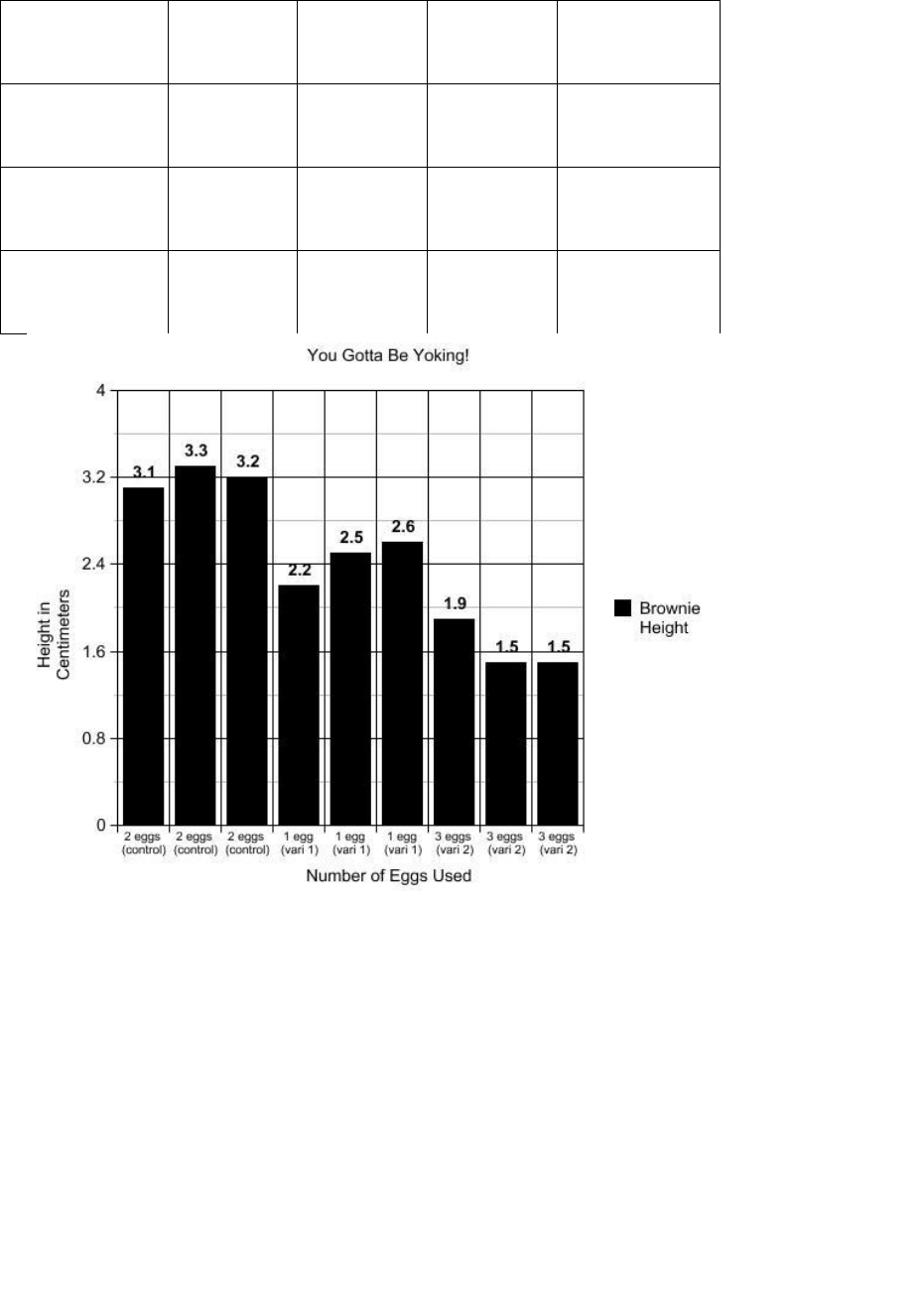
12
8. Data (a table/graph where test results are recorded)
Variable
Trial
1
Trial
2
Trial
3
Average
1 egg
2.2
cm
2.5
cm
2.6
cm
2.4 cm
2 eggs
3.1
cm
3.3
cm
3.2
cm
3.2 cm
3 eggs
1.9
cm
1.5
cm
1.5
cm
1.6 cm
9. Results (short explanation of the data)
“My data suggests that one egg makes brownies flat, but 3 eggs make them even
shorter, compared to my control.”
10. Conclusion (was your hypothesis correct or incorrect and why)
“My hypothesis was wrong because using 3 eggs made my brownies really short,
and especially gooey. Using 2 eggs instead of 3 made my brownies almost twice
as tall.”
11. Analysis (what you would change if you did this again)
“If I did this project again, I would experiment with the type of eggs I use instead
of the number of eggs.”
1
1

13
Bibliography Guide
Elementary science students (K-5) are expected to have 3 references. Secondary (6-12) science
students need to use 5 references. Below you will find examples for how to write a bibliography:
Book with author
L’Engle, Madeline. A Wrinkle in Time. Macmillian, 1964.
Book with editor
Gallo, Donald, ed. Sixteen. Four Winds, 1964.
Encyclopedia (or set of books with more than one volume)
“Africa.” Merit Students Encyclopedia (1985). Vol. 1, p. 83
Magazine article with an author
Smith, James A. “A New Treatment.” Time. Oct. 4, 1964, p. 25
Newspaper article
“Candidates Debate in State Capital.” Greensboro News & Record. February 28,
1988, Sec. A, p. 1
Interview
Melson, Jim. Telephone Interview. July 24, 1999.
Internet
http://www.mayoclinic.com/. January 26, 2011.
Online Formatting Resource
Source
Link
Purdue Owl
https://owl.english.purdue.edu/owl/
1
7

14
GCS Science Project and Research Plan Approval Form
Student, parent, teacher and adult sponsor must complete this form and have the project
approved before the student starts any experimentation.
Please print or type information
Student Name _______________________________________________ Grade___________________
School ____________________________________________________
Project Title: ________________________________________________________________________
Name(s) of other teammates with this project: (1.) ___________________________________________
(2.) ____________________________________ (each teammate in a group project must complete this form)
Teacher Name: __________________________ Parent/Guardian Name: ________________________
Where project is conducted: (check all that apply) Home ____ School _____ Field (park, farm, mall)
_____ Research Institution _____ Other (specific) ______________________________
Date of Student Acknowledgement: I understand the risks and possible dangers of the proposed
research plan. This projects are my own work. Initial: _____________ Date: ________________
Date of parent/guardian approval: I have read and understand the risks and possible dangers involved in
the research plan. I consent to this student participating in this project. Initial: __________ Date: ______
Date of teacher approval: I have read and understand the risks and possible dangers involved in the
research plan. Date of review of research plan: Initial: ______________ Date: __________________
Adult sponsor name: ________________________________ Phone number ____________________
Email ___________________________________ Date research plan reviewed: __________________
(Adult sponsor may be teacher, parent, community adult or professional scientist who is responsible for working with
students, evaluate possible risks, and ensure rules are followed)
Attach the student research plan to this form.
Please check any of the statements below that apply. If any of the statements below are checked, other forms will
be required.
_____ Project uses animals
_____ Project includes human for a survey, test, observations, etc.
_____ Project includes microorganism (middle and high grades only) (includes molds, or fungi,
bacteria, small pond organisms, compost, viruses, etc.)
_____Project includes potentially hazardous biological agents (human/animal fresh or frozen, teeth,
manure, urine, blood, other body fluids, or recombinant DNA)
_____ Project includes potentially hazardous activities chemical (weapons, projectiles, chemicals, power
tools, open flame or high heat, etc.)
A qualified scientist and review committee may be required for these types of high risk projects.
Additional forms attached (names or number): ____________________________________________

15
Project Template Guide
Topic of Interest
Due to my teacher____________________________
Please write a topic that is interesting to you on the line below (baking, riding a
bike, etc.).
______________________________________________________________
With the help of your parent/guardian and/or teacher, use the topic from above to
construct 2 testable questions. Remember, you should not already know the
answer, and it should be an idea you can test. Circle the number of the question you
would like to test the most (this will help your teacher guide your idea in the right
direction).
1. ________________________________________________________________
________________________________________________________________
2. ________________________________________________________________
________________________________________________________________
5

16
Experiment Research Plan
This must be completed BEFORE you start your experiment.
Due to my teacher on ________________________
1. Problem/Rationale/Purpose to investigate (I want to know...):
________________________________________________________________
________________________________________________________________
________________________________________________________________
________________________________________________________________
2. Hypothesis (I think…because…):
________________________________________________________________
________________________________________________________________
________________________________________________________________
3. Materials you plan to use:
6
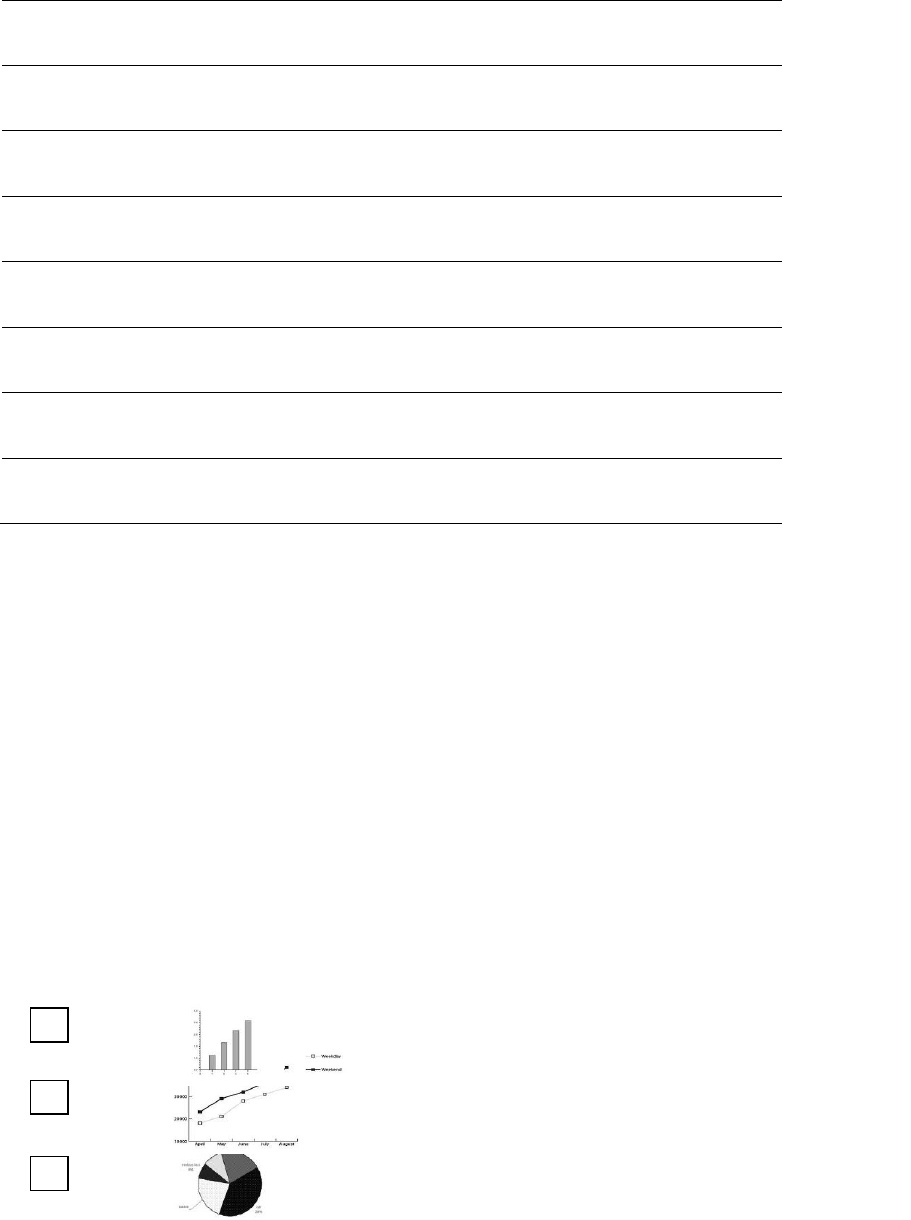
17
4. Procedures you plan to use (step by step):
1.
2.
3.
4.
5.
6.
7.
8.
9.
5. Variables:
________________________________________________________________
________________________________________________________________
6. List of Safety Issues (possible issues):
________________________________________________________________
________________________________________________________________
7. Data Analysis (how you will show data):
Which type of graph would best show my data?
Bar
Line
Pie
7

18
8. Bibliography (You must have at least 3 for elementary and 5 for secondary):
a. _____________________________________________________________
b. _____________________________________________________________
c. __________________________________________________________
d. _____________________________________________________________
e. ____________________________________________________________
8
Online Resources
www.sciencebuddies.org
http://www.ncsciencefair.org/
http://www.sciencefairadventure.com/
http://school.discoveryeducation.com/sciencefaircentral
http://www.jpl.nasa.gov/edu/teach/activity/how-to-do-a-science-fair-project/
http://www.education.com/science-fair

19
Science Project Checklist
Summary of Components
YES
NO
Forms
GCS Science Project and Research Plan Approval Form is required for all grades
and is included in this packet on page 14.
High School students must complete Forms 1, 1A, and 1B. Grades K-8 do not
need to complete these forms. These forms are included in this packet in
Appendices B, C, and D and they are available in the links below.
The Abstract Template is included in this packet and is available at the link below:
http://www.ncsciencefair.org/images/forms/NORTH_CAROLINA_OFFICIAL_ABSTRACT.pdf
Complete this form once experimentation is complete.
Experiment
Research Plan
Completed Experiment Research Plan (Pages 16-18)
Problem/Purpose
I want to know….
Hypothesis
"If _____ [I do this] _____, then _____[this]_____ will happen."
Materials
Bulleted list of all items used to complete experiment
Description of
Method and
Procedures
Describe procedures you plan to use (step by step)
Variables
List of Safety Issues
Data analysis
Data Collection
Record and display all of your results
Data Analysis
Review your data and note any trends
Conclusion
Summarize how your results prove or disprove your hypothesis
Bibliography
Elementary (K-5)- Three (3) references
Secondary (6-12)- Five (5) references
Abstract
All participants must complete an abstract.
Purpose
Procedure
Data
Conclusion
References: Rules/Regulations and research guidelines are adapted from Intel International Science and
Engineering Fair International Rules and Guidelines 2018. Available at:
https://sspcdn.blob.core.windows.net/files/Documents/SEP/ISEF/2018/Rules/Book.pdf
